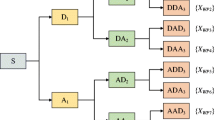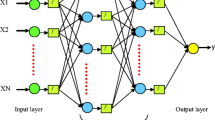Abstract
Accurate predicting of lake level fluctuations is essential and basic in water resources management for water supply purposes. The predicting of lake level is complicated because of it is affected by nonlinear hydrological processes. This paper applies integrated wavelet and auto regressive moving average (ARMA), adaptive neuro fuzzy inference system (ANFIS) and support vector regression (SVR) models for forecasting monthly lake level fluctuations. First, lake level time series is decomposed into low and high frequency components by using discrete wavelet transform. Then, each component is separately predicted by using ARMA, ANFIS and SVR models. Finally, the predicted components are summed to obtain estimated original lake level time series. The performance of the proposed WSVR (Wavelet-SVR), WANFIS (Wavelet-ANFIS) and WARMA (Wavelet-ARMA) models is compared with single ARMA, SVR and ANFIS models. Results show that the integrated models give better precision in forecasting lake levels in the study region when compared to single models. WSVR model is found to be slightly better than the other integrated models.






Similar content being viewed by others
References
Adamowski J, Chan HF (2011) A wavelet neural network conjunction model for groundwater level forecasting. J Hydrol 407(1):28–40
Altunkaynak A, Ozger M, Sen Z (2003) Triple diagram model of level fluctuations in Lake Van, Turkey. Hydrol Earth Syst Sci 7(2):235–244
Aytek A, Kisi O, Guven A (2014) A genetic programming technique for forecasting lake level fluctuations of Lake Van in Turkey. Hydrol Res 45(4–5):529–539
Box GE, Jenkins GM, Reinsel GC (1970) Time series analysis forecasting and control. Holden Day, San Francisco
Box GEP, Jenkins GM, Reinsel GC (1997) Time series analysis: forecasting and control. China Statistic Press, Beijing
Chen SH, Lin YH, Chang LC, Chang FJ (2006) The strategy of building a flood forecast model by neuro-fuzzy network. Hydrol Process 20:1525–1540
Chou CM, Wang RY (2002) On-line estimation of unit hydrographs using the wavelet-based LMS algorithm. Hydrol Sci J 47(5):721–738
Cimen M (2008) Estimation of daily suspended sediments using support vector machines. Hydrol Sci J 53(3):656–666
El-Shafie A, Taha MR, Noureldin A (2007) A neuro-fuzzy model for inflow forecasting of the Nile River at Aswan High Dam. Water Resour Manag 21(3):533–556
Jang JSR, Sun CT, Mizutani E (1997) Neuro-fuzzy and soft computing: a computational approach to learning and machine intelligence. Prentice-Hall, Eaglewood Cliffs, pp 665–685
Kadioglu M, Sen Z, Batur F (1994) The greatest soda-water lake in the world and how it is influenced by climatic change. Ann Geophys 15:1489–1497
Kazeminezhad MH, Etemad-shahidi A, Mousavi SJ (2005) Application of fuzzy inference system in the prediction of wave parameters. Ocean Eng 32:1709–1725
Keskin ME, Terzi O, Taylan D (2004) Fuzzy logic model approaches to daily pan evaporation estimation in Western Turkey. Hydrol Sci J 49(6):1001–1010
Keskin ME, Taylan D, Terzi O (2006) Adaptive neural-based fuzzy inference system (ANFIS) approach for modelling hydrological time series. Hydrol Sci J 51(4):588–598
Kisi O (2006) Daily pan evaporation modeling using a neuro-fuzzy computing technique. J Hydrol 329:636–646
Kisi O, Cimen M (2009) Evapotranspiration modelling using support vector machines. Hydrol Sci J 54(5):918–928
Kisi O, Cimen M (2011) Wavelet-support vector machine conjunction model for monthly streamflow forecasting. J Hydrol 399(1):450, 132–140
Kisi O, Cimen M (2012) Precipitation forecasting by using wavelet support vector machine conjunction model. Eng Appl Artif Intell 25:783–792
Kisi O, Ozturk O (2007) Adaptive neurofuzzy computing technique for evapotranspiration estimation. J Irrig Drain E 133(4):368–379
Kisi O, Shiri J (2011) Precipitation forecasting using wavelet-genetic programming and wavelet-neuro-fuzzy conjunction models. Water Resour Manag 25:3135–3152
Kisi O, Shiri J, Nikoofar B (2012) Forecasting daily lake levels using artificial intelligence approaches. Comput Geosci 41:169–180
Mallat SG (1989) A theory for multi resolution signal decomposition: the wavelet representation. Trans Pattern Anal Mach Intell 11:674–693
Mohammadi K, Eslami HR, Kahawita R (2006) Parameter estimation of an ARMA model for river flow forecasting using goal programming. J Hydrol 331(1):293–299
Moosavi V, Vafakhah M, Shirmohammadi B, Behnia N (2013) A wavelet -ANFIS hybrid model for groundwater level forecasting for different prediction periods. Water Resour Manag 27:1301–1321
Platt JC (1999) Fast training of support vector machines using sequential minimal optimization. In: Sch olkopf B, Burges CJC, Smolar AJ (eds) Advances in Kernel methods—support vector learning. MIT Press, Cambridge
Radhika Y, Shashi M (2009) Atmospheric temperature prediction using support vector machines. IJCTE 1(1):55–58
Rajaee T (2010) Wavelet and neuro-fuzzy conjunction approach for suspended sediment prediction. Clean-Soil Air Water 38(3):275–286
Salas JD, Delleur JW, Yevjevich V, Lane WL (1980) Applied modeling of hydrologic time series. Water Resources Publications, Littleton
Sen Z, Kadioglu M, Batur E (2000) Stochastic modelling of the Van Lake monthly level fluctuations in Turkey. Theor Appl Climatol 65:99–110
Shiri J, Kisi O, Yoon H, Lee KK, Nazemi AH (2013) Predicting groundwater level fluctuations with meteorological effect implications- A comparative study among soft computing techniques. Comput Geosci 56:32–44
Shirmohammadi B, Vafakhah M, Moosavi V, Moghaddamnia A (2012) Application of several data-driven techniques for predicting groundwater level. Water Resour Manag. doi:10.1007/s11269-012-0194-y
Sivapragasam C, Liong S-Y, Pasha MFK (2001) Rainfall and runoff forecasting with SSA–SVM approach. J Hydroinf 3(3):141–152
Takagi T, Sugeno M (1985) Fuzzy identification of systems and its applications to modeling and control. IEEE Trans Syst Man Cybern SMC-15(1):116–132
Vapnik VN (1995) The nature of statistical learning theory. Springer, New York
Wang W, Ding S (2003) Wavelet network model and its application to the predication of hydrology. Nat Sci 1:67–71
Wei S, Yang H, Song J, Abbaspour K, Xu Z (2013) A wavelet-neural network hybrid modelling approach for estimating and predicting river monthly flows. Hydrol Sci J 58(2):374–389
Wu CL, Chau KW, Fan C (2010a) Prediction of rainfall time series using modular artificial neural networks coupled with data-preprocessing techniques. J Hydrol 389:146–167
Wu J, Liu M, Jin L (2010b) Least square support vector machine ensemble for daily rainfall forecasting based on linear and nonlinear regression, Advances in neural network research and applications. Lect Notes Electr Eng 67(1):55–64
Yarar A (2014) A hybrid wavelet and neuro-fuzzy model for forecasting the monthly streamflow data. Water Resour Manag 28:553–565
Yarar A, Onucyıldız M, Copty NK (2009) Modelling level changes in lakes using neuro-fuzzy and artificial neural networks. J Hydrol 365:329–334
Zhou HC, Peng Y, Liang G-H (2008) The research of monthly discharge predictor-corrector model based on wavelet decomposition. Water Resour Manag 22(2):217–227
Author information
Authors and Affiliations
Corresponding author
Rights and permissions
About this article
Cite this article
Shafaei, M., Kisi, O. Lake Level Forecasting Using Wavelet-SVR, Wavelet-ANFIS and Wavelet-ARMA Conjunction Models. Water Resour Manage 30, 79–97 (2016). https://doi.org/10.1007/s11269-015-1147-z
Received:
Accepted:
Published:
Issue Date:
DOI: https://doi.org/10.1007/s11269-015-1147-z




